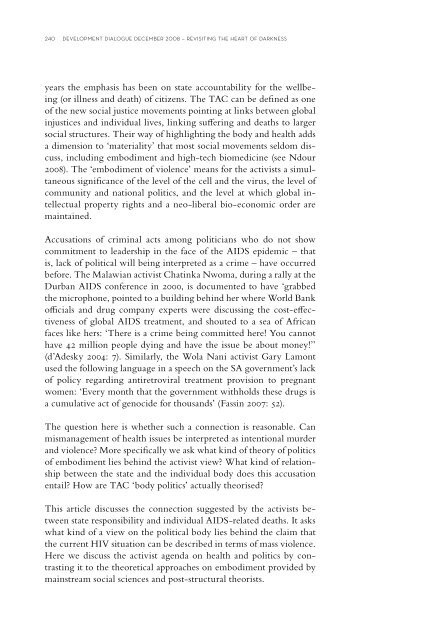60 years after the UN Convention - Dag Hammarskjöld Foundation
60 years after the UN Convention - Dag Hammarskjöld Foundation
60 years after the UN Convention - Dag Hammarskjöld Foundation
Create successful ePaper yourself
Turn your PDF publications into a flip-book with our unique Google optimized e-Paper software.
240 development dialogue december 2008 – revisiting <strong>the</strong> heart of darkness<br />
<strong>years</strong> <strong>the</strong> emphasis has been on state accountability for <strong>the</strong> wellbeing<br />
(or illness and death) of citizens. The TAC can be defi ned as one<br />
of <strong>the</strong> new social justice movements pointing at links between global<br />
injustices and individual lives, linking suff ering and deaths to larger<br />
social structures. Their way of highlighting <strong>the</strong> body and health adds<br />
a dimension to ‘materiality’ that most social movements seldom discuss,<br />
including embodiment and high-tech biomedicine (see Ndour<br />
2008). The ‘embodiment of violence’ means for <strong>the</strong> activists a simultaneous<br />
signifi cance of <strong>the</strong> level of <strong>the</strong> cell and <strong>the</strong> virus, <strong>the</strong> level of<br />
community and national politics, and <strong>the</strong> level at which global intellectual<br />
property rights and a neo-liberal bio-economic order are<br />
maintained.<br />
Accusations of criminal acts among politicians who do not show<br />
commitment to leadership in <strong>the</strong> face of <strong>the</strong> AIDS epidemic – that<br />
is, lack of political will being interpreted as a crime – have occurred<br />
before. The Malawian activist Chatinka Nwoma, during a rally at <strong>the</strong><br />
Durban AIDS conference in 2000, is documented to have ‘grabbed<br />
<strong>the</strong> microphone, pointed to a building behind her where World Bank<br />
offi cials and drug company experts were discussing <strong>the</strong> cost-eff ectiveness<br />
of global AIDS treatment, and shouted to a sea of African<br />
faces like hers: ‘There is a crime being committed here! You cannot<br />
have 42 million people dying and have <strong>the</strong> issue be about money!’’<br />
(d’Adesky 2004: 7). Similarly, <strong>the</strong> Wola Nani activist Gary Lamont<br />
used <strong>the</strong> following language in a speech on <strong>the</strong> SA government’s lack<br />
of policy regarding antiretroviral treatment provision to pregnant<br />
women: ‘Every month that <strong>the</strong> government withholds <strong>the</strong>se drugs is<br />
a cumulative act of genocide for thousands’ (Fassin 2007: 52).<br />
The question here is whe<strong>the</strong>r such a connection is reasonable. Can<br />
mismanagement of health issues be interpreted as intentional murder<br />
and violence? More specifi cally we ask what kind of <strong>the</strong>ory of politics<br />
of embodiment lies behind <strong>the</strong> activist view? What kind of relationship<br />
between <strong>the</strong> state and <strong>the</strong> individual body does this accusation<br />
entail? How are TAC ‘body politics’ actually <strong>the</strong>orised?<br />
This article discusses <strong>the</strong> connection suggested by <strong>the</strong> activists between<br />
state responsibility and individual AIDS-related deaths. It asks<br />
what kind of a view on <strong>the</strong> political body lies behind <strong>the</strong> claim that<br />
<strong>the</strong> current HIV situation can be described in terms of mass violence.<br />
Here we discuss <strong>the</strong> activist agenda on health and politics by contrasting<br />
it to <strong>the</strong> <strong>the</strong>oretical approaches on embodiment provided by<br />
mainstream social sciences and post-structural <strong>the</strong>orists.

















